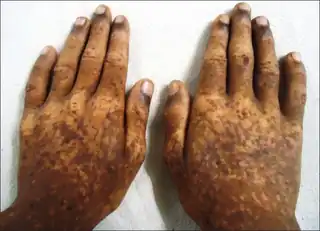Dyschromatosis symmetrica hereditaria
| Dyschromatosis symmetrica hereditaria | |
|---|---|
| Other names: Reticulate acropigmentation of Dohi[1] | |
 | |
| Pale spots on darkened hands | |
| Specialty | Dermatology |
Dyschromatosis symmetrica hereditaria, also known as symmetrical dyschromatosis of the extremities, is a type of pigmentation disorder of the skin.[1] It presents with progressively darkening skin with pale small flat spots appearing in a lace-like pattern typically on hands and feet.[1]
It tends to run in families.[1] Most are inherited as autosomal dominant, with a mutation of the ADAR1 gene.[2]
It is rare, and presents primarily in the Japanese, but has also been found to affect individuals from Europe, India and the Caribbean.[1]
Signs and symptoms
It presents with progressively darkening skin with pale small flat spots appearing in a lace-like pattern typically on hands and feet.[1]
Genetics

Most are inherited as autosomal dominant, with a mutation of the ADAR1 gene.[2]
Diagnosis
Diagnosis is by genetic testing.[1]
See also
References
- 1 2 3 4 5 6 7 James, William D.; Elston, Dirk; Treat, James R.; Rosenbach, Misha A.; Neuhaus, Isaac (2020). "36. Disturbances of pigmentation". Andrews' Diseases of the Skin: Clinical Dermatology (13th ed.). Edinburgh: Elsevier. p. 865. ISBN 978-0-323-54753-6. Archived from the original on 2023-06-30. Retrieved 2023-05-26.
- 1 2 Kono, Michihiro; Akiyama, Masashi (1 February 2019). "Dyschromatosis symmetrica hereditaria and reticulate acropigmentation of Kitamura: An update". Journal of Dermatological Science. 93 (2): 75–81. doi:10.1016/j.jdermsci.2019.01.004. ISSN 0923-1811. PMID 30692041.
External links
| Classification | |
|---|---|
| External resources |
|